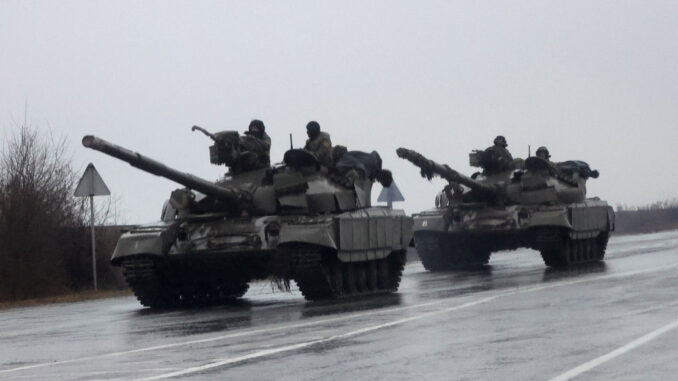
Why oil prices will remain over $100 even if Putin does not attack but annexes through force.
February 22, 2022
The world is in an energy crisis, and as I have said before, the world will go to war over energy. Putin is already on the path to becoming the “Energy Czar” of the world. Let’s talk about some updates in Europe, then follow up on why WTI oil will remain high no matter the outcome of the race to be “Energy Czar”.
This morning the U.N. is having an emergency meeting of the security council, and the United States, UK, and the EU are looking at sanctions against the billionaires in Russia and not approving the Nord Stream 2 pipeline. All of this is because Putin declared Russia’s recognition of the Donetsk and Luhansk regions as independent republics. What has everyone’s attention is the fine print. He will send “Peace Keeping Forces” to help out. Donetsk and Luhansk are shown in the graphic below as they only step one.
Sources: Natural Earth; European Commission
Step 2 and 3 will be more difficult but is already in motion. The Sea of Azov is to the east of Crimea, which was already annexed. Draw a line straight west from Mariupol and you get the next main target. The top of the Crimea peninsula. The sub-bases, a direct land bridge to military bases to the Black Sea are critical for Russia’s dominance of the energy markets. “Annexeing through force” is very smart and a great chess move.
Why WTI will remain over $100 even if Putin’s plans stall.
Now that we are up to date on Putin, let’s head to the United States energy markets. There are several key points that have a tremendous impact on the supply side of the equation. The U.S. East and West coasts import most of their energy (both LNG and oil) from Russia, Norway, Trinidad, China, and Iran. The coasts are very concerned about Brent’s international oil pricing.
The rest of the U.S. requires imports of heavier oil from Canada and others to mix with the lighter shale oil produced in the states. On the natural gas side, we are now the largest exporter in the world over LNG. Most of that comes from the Gulf Coast supplied from the Hanensville in Texas and Louisiana, and the Permian in West Texas. Hence the pricing model for WTI and natural gas are market-are driven on a smaller scale outside of some world influences.
Lack of capital.
As I also have talked about in several articles earlier, the ESG movement has limited the amount of capital E&P companies available to drill just to replace the normal decline curves and stay at current production levels. In the past oil price booms, E&P operators jumped at the chance to drill and rush for profits. Now the mantra is “Fiscally Responsible”, which is code for limited drilling programs. We will see rig counts increase, but will not be able to keep up with demand for increasing demand. The graphic below from Rystad Energy shows the spending cap on E&P companies through 2024.
Source; Rystad
“Over the last several years, we grew too much,” Pioneer Natural Resources Co. CEO Scott Sheffield said in an interview. “We’ve had two price collapses, and it’s primarily due to U.S. shale competing with OPEC” while giving little thought to investors, he said. Sheffield summed it up nicely.
Lack of oilfield workers.
Now that people want the oil just “turned on” it won’t happen. During the pandemic world, supply dropped 70% and hit the bottom in the “Black April” of 2020. The Oil Field Service companies laid off thousands of employees, many went bankrupt, and rigs are sitting in boneyards. The graphic below from Bloomberg is a good representation of the covid impact on demand. Demand increased faster than anyone could predict.
In this demand for oil bull run, there is a gigantic shortage of oilfield workers that cannot be replaced in years and coupled with the lack of commitment for long-term drilling projects this is a permanent fixture to the supply equation.
Lack of commitment.
As stated above, oil and gas companies are under pressure from the ESG movement and lack capital. The regulations and the current administration’s attack on the energy market solidify the total lack of commitment to invest in CapEx and drilling programs. This is a key impact on the long-term bull run on WTI oil prices.
WTI vs. Brent pricing battle.
There is a lack of trust in the world oil market pricing structure, and forces are in play to see a pricing control between those two. There are too many variables and I will address those in future articles.
The Bottom Line.
You can see that the old pricing matrices of supply and demand are no longer the easy price matrix they used to be. The geopolitical, political, ESG energy movement, long term increase for energy have an integrated formula for the long-term bull run on oil prices. Our research team has data supporting the $120 to $135 oil price in Q2 and Q3 based upon these factors. Things are shaping out for a long bull run at these prices.
As always check with your CPA if alternative investments are good for your portfolio Take the assessment and see if it is right for you HERE.
Please reach out to our team at any time for answers to your questions.
Jay R. Young, CEO, King Operating
And visit the King Operating Website for more market information and insights.



